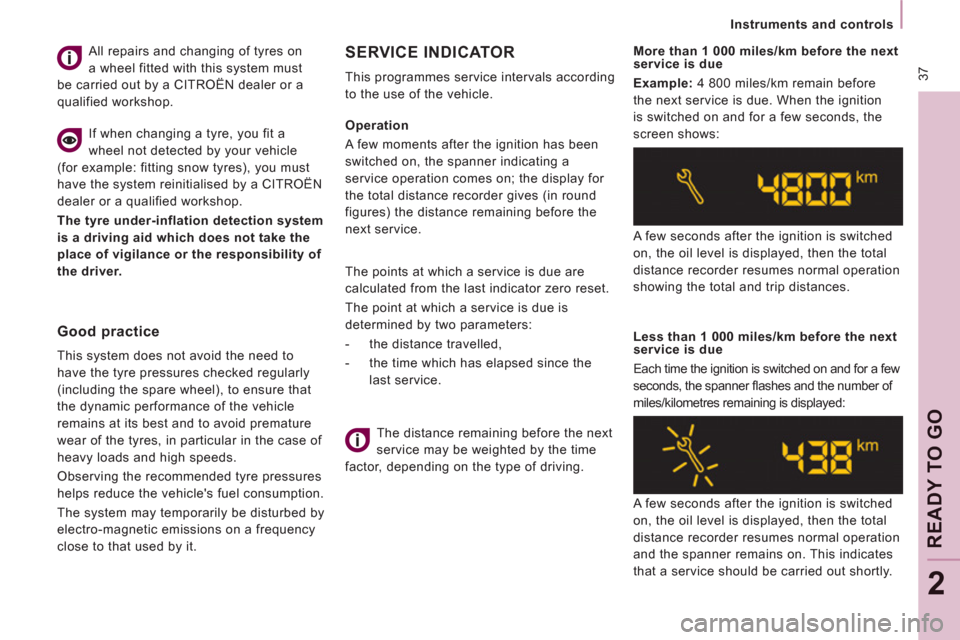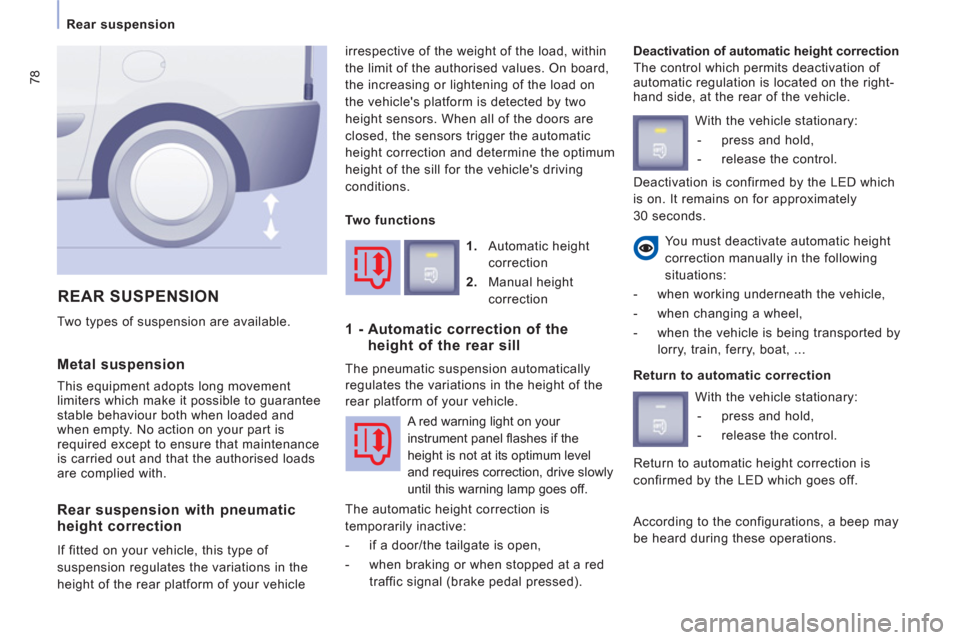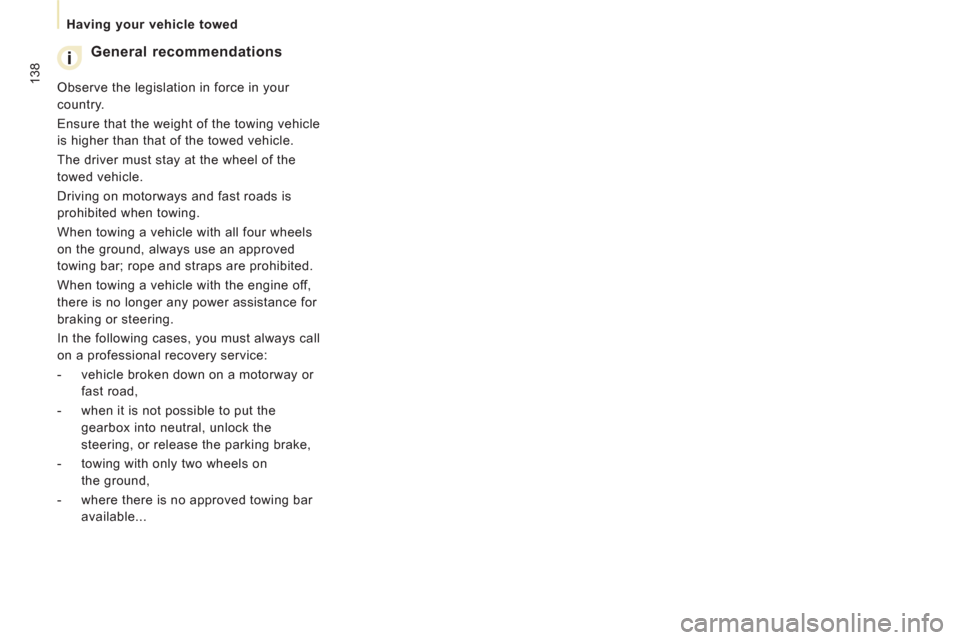weight Citroen JUMPY 2012 2.G Owner's Manual
[x] Cancel search | Manufacturer: CITROEN, Model Year: 2012, Model line: JUMPY, Model: Citroen JUMPY 2012 2.GPages: 268, PDF Size: 9.71 MB
Page 5 of 268

CONTENT
S
Contents
39. TECHNOLOGY onBOARD 5. ACCESSORIES
102-105
6. CHECKS 106-116
7. QUICK HELP 117-139
The "Technology on board"
section presents the new radio/
navigation systems.
Towing a trailer 102Other accessories 104Professional range 105
Opening the bonnet 106Diesel engines 107Petrol engine 108Levels 109Checks 111Fuel 114Circuit disarmed 115Diesel priming pump 115
Battery 117Puncture repair kit 119Changing a wheel 121Removable snow screen 125Changinga bulb 126a fuse 131
a windscreen wiper blade 136Towing the vehicle 137
8. TECHNICAL DATA140-148
Dimensions 140Weights 146Engines 147Identification features 148
10. VISUAL SEARCH 149-154
Emergency or assistance 9.1NaviDrive 9.5MyWay 9.51
Audio system 9.85
The "Location" section assists
you in finding the controls
and functions and their
associated page numbers on
the schematic outlines of the
vehicle (visual index).
Exterior 149Instruments and controls 150Interior 152Technical data - Maintenance153Model code 154
Page 39 of 268

37
Instruments and controls
READY TO GO
2
Operation
A few moments after the ignition has been
switched on, the spanner indicating a
service operation comes on; the display for
the total distance recorder gives (in round
figures) the distance remaining before the
next service.
A few seconds after the ignition is switched
on, the oil level is displayed, then the total
distance recorder resumes normal operation
showing the total and trip distances.
Less than 1 000 miles/km before the next
service is due
Each time the ignition is switched on and for a few
seconds, the spanner fl ashes and the number of
miles/kilometres remaining is displayed:
A few seconds after the ignition is switched
on, the oil level is displayed, then the total
distance recorder resumes normal operation
and the spanner remains on. This indicates
that a service should be carried out shortly. The distance remaining before the next
service may be weighted by the time
factor, depending on the type of driving.
More than 1 000 miles/km before the next
service is due
Example:
4 800 miles/km remain before
the next service is due. When the ignition
is switched on and for a few seconds, the
screen shows:
SERVICE INDICATOR
This programmes service intervals according
to the use of the vehicle.
The points at which a service is due are
calculated from the last indicator zero reset.
The point at which a service is due is
determined by two parameters:
- the distance travelled,
- the time which has elapsed since the
last service. All repairs and changing of tyres on
a wheel fitted with this system must
be carried out by a CITROËN dealer or a
qualified workshop.
Good practice
This system does not avoid the need to
have the tyre pressures checked regularly
(including the spare wheel), to ensure that
the dynamic performance of the vehicle
remains at its best and to avoid premature
wear of the tyres, in particular in the case of
heavy loads and high speeds.
Observing the recommended tyre pressures
helps reduce the vehicle's fuel consumption.
The system may temporarily be disturbed by
electro-magnetic emissions on a frequency
close to that used by it. If when changing a tyre, you fit a
wheel not detected by your vehicle
(for example: fitting snow tyres), you must
have the system reinitialised by a CITROËN
dealer or a qualified workshop.
The tyre under-inflation detection system
is a driving aid which does not take the
place of vigilance or the responsibility of
the driver.
Page 69 of 268

67
Seats
EASE OF USE
and COMFOR
T
3
FRONT SEATS
Depending on the version and configuration
of your vehicle, different front seats are
fitted, either:
- a driver's seat and a passenger seat,
- an individual driver's seat and
a two-seat passenger bench.
Depending on the models, the following
adjustments are available:
3 - Driver's seat height adjustment
Depending on the version and configuration
of your vehicle, you have either:
- a passive adjustment: pull the handle
upwards then take your weight off the
seat to raise, or push on the seat to
lower,
2 - Seat back angle adjustment
Pull the lever upwards and set the required
angle.
1 - Forwards/backwards adjustment
Lift the bar and slide the seat forwards or
backwards.
Page 80 of 268

78
Rear suspension
Metal suspension
This equipment adopts long movement
limiters which make it possible to guarantee
stable behaviour both when loaded and
when empty. No action on your part is
required except to ensure that maintenance
is carried out and that the authorised loads
are complied with. irrespective of the weight of the load, within
the limit of the authorised values. On board,
the increasing or lightening of the load on
the vehicle's platform is detected by two
height sensors. When all of the doors are
closed, the sensors trigger the automatic
height correction and determine the optimum
height of the sill for the vehicle's driving
conditions.
Deactivation of automatic height correction
The control which permits deactivation of
automatic regulation is located on the right-
hand side, at the rear of the vehicle.
REAR SUSPENSION
You must deactivate automatic height
correction manually in the following
situations:
- when working underneath the vehicle,
- when changing a wheel,
- when the vehicle is being transported by
lorry, train, ferry, boat, ...
Two types of suspension are available.
Rear suspension with pneumatic
height correction
If fitted on your vehicle, this type of
suspension regulates the variations in the
height of the rear platform of your vehicle
1.
Automatic height
correction
2.
Manual height
correction
1 - Automatic correction of the
height of the rear sill
The pneumatic suspension automatically
regulates the variations in the height of the
rear platform of your vehicle.
A red warning light on your
instrument panel fl ashes if the
height is not at its optimum level
and requires correction, drive slowly
until this warning lamp goes off.
The automatic height correction is
temporarily inactive:
- if a door/the tailgate is open,
- when braking or when stopped at a red
traffic signal (brake pedal pressed). With the vehicle stationary:
- press and hold,
- release the control.
Return to automatic correction
With the vehicle stationary:
- press and hold,
- release the control.
According to the configurations, a beep may
be heard during these operations.
Two functions
Return to automatic height correction is
confirmed by the LED which goes off. Deactivation is confirmed by the LED which
is on. It remains on for approximately
30 seconds.
Page 99 of 268

97
Child safety
SAFETY
4
GENERAL POINTS RELATING TO
CHILD SEATS
"Rearwards-facing"
Recommended on the rear seats up to the
age of 2.
When a "rearwards-facing" child seat is
installed on the front passenger seat, it
is essential that the passenger air bag is
deactivated. Otherwise, the child would risk
being seriously injured or killed if the airbag
were to inflate.
"Forwards-facing"
Recommended on the rear seats over the
age of 2.
When a "forwards-facing" child seat is
installed on the front passenger seat, leave
the passenger air bag activated.
CHILD SEAT IN THE FRONT
The rules for carrying children are specific to
each country. Consult the current legislation
in your country.
Please consult the list of seats approved
in your country. The Isofix mountings, the
rear seats, the passenger airbag and the
deactivation of this airbag depend on the
version sold.
Although one of CITROËN's main criteria
when designing your vehicle, the safety of
your children also depends on you.
For maximum safety, please follow these
precautions:
- all children under the age of 12 or less
than one metre fifty tall must travel in
approved child seats suited to their
weight, on seats fitted with a seat belt or
ISOFIX mountings,
- statistically, the safest seats in your
vehicle for the transportation of children
are the rear seats,
- a child weighing less than 9 kg must
travel in the "rearwards-facing" position
both in the front and in the rear,
- the passenger must not travel with a
child on his lap.
Page 102 of 268

100
Child safety
a: Group 0: from birth to 13 kg. Infant car seats and "car cots" cannot be installed on the front passenger seat.
b: consult the legislation in force in your country before installing your child on this seat.
U: seat suitable for the installation of a child seat secured using a seat belt and universally approved, "rear facing" and/or "forward facing".
INSTALLING CHILD SEATS ATTACHED USING THE SEAT BELT
This table indicates the options for installing child seats secured using a seat belt and universally approved in accordance with the weight of
the child and the seat in the vehicle.
Seat
Weight of the child and indicative age
Under 13 kg
(groups 0 (a) and 0+)
Up to approx 1 year
From 9 to 18 kg
(group 1)
1 to 3 years approx
From 15 to 25 kg
(group 2)
3 to 6 years approx
From 22 to 36 kg
(group 3)
6 to 10 years approx
Row 1 (b)
Individual seat
U
U
U
U
Bench, outer seat
U
U
U
U
Bench,
centre seat
L1
-
L3, L4, L5
L3, L4, L5
Page 104 of 268

102
Towing a trailer
For more information about weights,
refer to the administrative documents
(registration document, ...) or to the
"Weights" section of chapter 8.
TOWING A TRAILER, CARAVAN, BOAT, ETC...
Distribution of loads
Distribute the load in the trailer so that the
heaviest objects are as close as possible
to the axle and the nose weight is close to
the maximum authorised without, however,
exceeding it.
Cooling
Towing a trailer on a slope increases the
coolant temperature.
As the fan is electrically controlled, its
cooling capacity is not dependent on the
engine speed.
Driving advice
A towed vehicle must free wheel: gearbox in
neutral.
Page 106 of 268

104
Equipment
OTHER ACCESSORIES
For any work on your vehicle, use
a qualified workshop that has the
technical information, competence and
equipment required, which a CITROËN
dealer is able to provide.
ROOF BARS
Maximum load: 100 kilograms.
Accessory not available on the
H2 version.
ROOF RACK
To install the transverse roof bars, use the
fixings provided for this purpose.
Maximum load: 170 kilograms.
Accessory not available on the
H2 version.
INTERIOR RACK
This rack allows you to carry long items of low weight (electrical conduits, pipes, etc...).
Page 140 of 268

138
Having your vehicle towed
General recommendations
Observe the legislation in force in your
country.
Ensure that the weight of the towing vehicle
is higher than that of the towed vehicle.
The driver must stay at the wheel of the
towed vehicle.
Driving on motorways and fast roads is
prohibited when towing.
When towing a vehicle with all four wheels
on the ground, always use an approved
towing bar; rope and straps are prohibited.
When towing a vehicle with the engine off,
there is no longer any power assistance for
braking or steering.
In the following cases, you must always call
on a professional recovery service:
- vehicle broken down on a motorway or
fast road,
- when it is not possible to put the
gearbox into neutral, unlock the
steering, or release the parking brake,
- towing with only two wheels on
the ground,
- where there is no approved towing bar
available...
Page 147 of 268

145
Dimensions
TECHNI
CAL DAT
A
8
PLATFORM CAB (mm)
L2
L Overall length
5 016
A Wheelbase
3 122
B Front overhang
975
C Rear overhang
920
Max rear body overhang
1 420
D Overall width (excluding mirrors)
1 895
E Width of front track
1 574
F Width of rear track
1 574
- Gross vehicle weight
-
- Max weight at the front
1 400
- Max weight at the rear
1 700